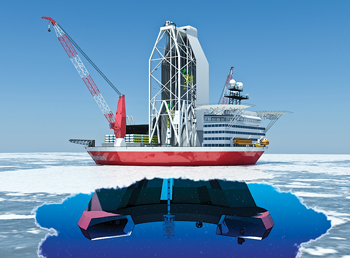Dutch engineering and manufacturing firm Huisman Equipment B.V. entered the offshore drilling market 10 years ago with a new type of drilling mast. Now the company has three complete rig designs, one for a drillship, HuisDrill 12000, and two for semisubmersibles, JBF 14000 and, most recently, JBF Arctic, Fig. 1.

Fig. 1. An artist’s rendering of the JBF Arctic surrounded by ice.

TABLE 1. SELECT 10,000-FT-PLUS DRILLSHIPS UNDER CONSTRUCTION (Click to enlarge)
According to a paper submitted to the 2011 Offshore Technology Conference by Huisman’s Alexei Bereznitski and David Roodenburg, when operators need to drill in deeper icy waters, reinforced drillships with dynamic positioning (DP) can be used, but they have their drawbacks. “Even though these vessels are properly reinforced for operating, or actually for transiting, in ice, their station keeping capability is very limited,” they wrote. “When a vessel cannot choose heading to meet the ice with its bow, DP or a mooring system can only withstand very light ice loads.”
However, Bereznitski and Roodenburg said that typical ice-capable rigs are conical in shape at the water line to break the ice, indicating that these are usually tall spar units or shorter cylindrical units, like Kulluk. They explained, “The seakeeping performance of the relatively short cylindrical units is quite poor since the natural heave period is well within the typical wave periods range. The spar type units have good seakeeping characteristics, but the ability to move between the drilling locations is very limited and the application of these units requires large water depths.”
The design of Huisman’s JBF Arctic drilling unit resolves these issues by allowing the rig to work at two operating drafts. In open waters, the JBF Arctic would operate at the same draft as any traditional semisubmersible. However, when operating in ice, the rig will ballast down to partly submerge the deckbox to protect the riser from ice, rubble and ice ridges.
The deckbox has an angled, ice-strengthened structure to deflect or break ice. The unit would be strengthened for transit through broken ice, though an icebreaker would be needed to assist in the move. The design also calls for a double-activity derrick and dual remotely operated vehicle (ROV) stations.
The hull is similar to Sevan Marine’s vessels, such as the Sevan Driller, in that it is cylindrical with a round deck. However, where a Sevan unit will have essentially vertical sides, the JBF Artcic’s sides are angled inward from both the top and the bottom, with the bottom portion being made up of eight columns.
The 250-person JBF Arctic is designed to drill wells in sub-Arctic conditions where it can be moored in ice up to 5–6.5 ft thick. A 16-point wire-line mooring system is the chief station-keeping measure for ice-infested waters, with thrusters available to provide extra support. The unit is able to operate in water depths between 197 ft and 4,921 ft while drilling to a total depth of 40,000 ft.

